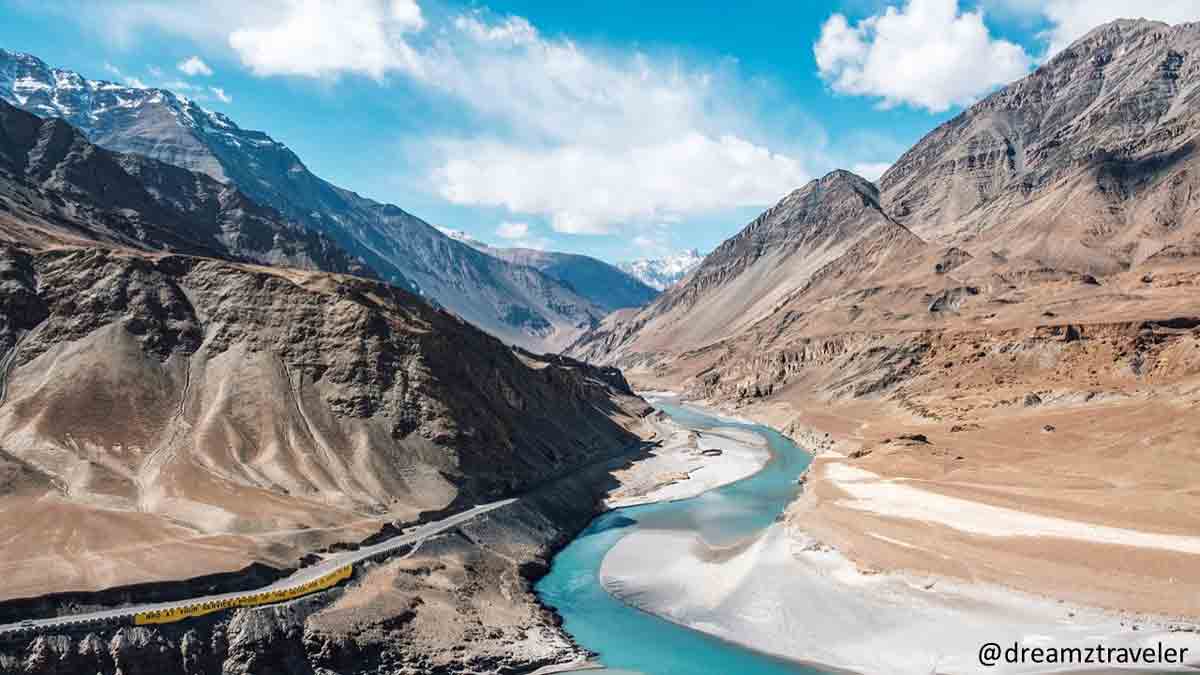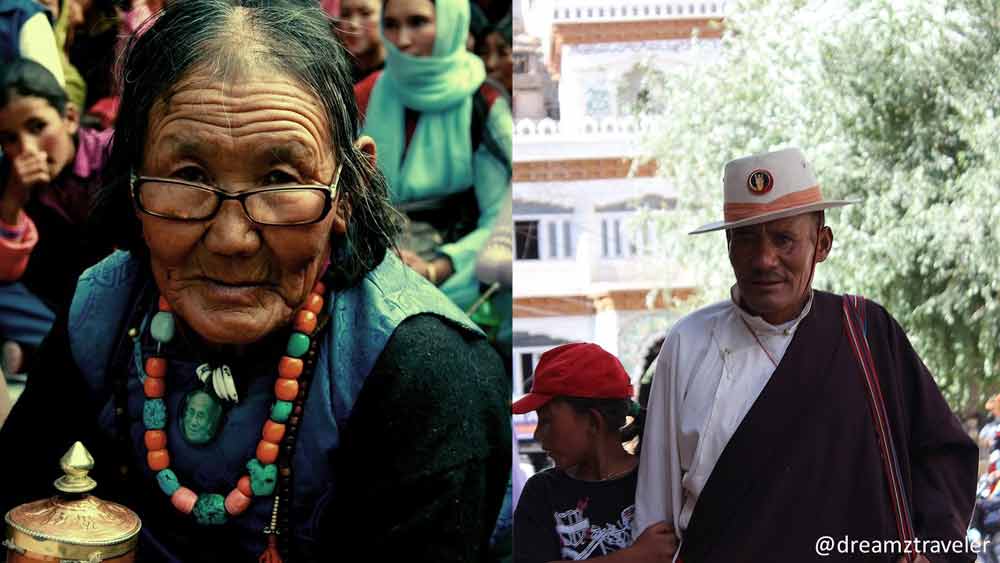Explore Leh Ladakh: The Land of High Passes
Located in the northernmost reaches of India, Leh Ladakh is filled with adventurers with its stark beauty, high-altitude landscapes, and vibrant culture. Known as “The Land of High Passes,” Leh Ladakh offers a unique combination of ancient monasteries, snow-capped peaks, and serene lakes. In this blog post, we’ll explore the heart of Ladakh, uncovering its hidden gems and practical travel tips.

The Geography of Leh Ladakh
Leh Ladakh has an area of 59,146 square kilometers, making it the largest union territory in India. The Karakoram Range surrounds its rugged terrain to the north and the Zanskar Range to the south. The Indus River flows through this high-altitude desert.
Offbeat Destinations – Leh Ladakh Trip
While Pangong Tso Lake and Khardung La Pass are well-known, let’s explore some lesser-known places:
 Ladakh Glacier[/caption]
Ladakh Glacier[/caption]
Zanskar Valley
- This remote valley lies between the Great Himalayan Range and the Zanskar Range.
- Explore ancient monasteries and immerse yourself in Buddhist culture.
- Picturesque villages and pristine wilderness await intrepid travelers.
Turtuk
- The northernmost village in India offers a glimpse into Balti culture. Apricot orchards and stunning mountain views add to its charm.
- Apricot orchards and stunning mountain views add to its charm.
Leh Ladakh

“Leh Ladakh, which is a lovely place to visit, is the largest town in the Ladakh region of north Indian country and it is very famous because of its beautiful landscape, historical monuments, and rich cultural heritage.”
Key Attractions to Experience in Leh Ladakh are
Leh Palace: The historic royal residence with sweeping views of the town and the surrounding mountains, was constructed in the 17th century. The Potala Palace in Lhasa Tibet is comparable in architecture.
Shanti Buddha: Perched atop a hill, this white-domed Buddhist stupa provides breathtaking views of Leh’s surroundings. It was constructed to honor 2500 years of Buddhism. It serves to advance global peace and prosperity.
The Thiksey Monastery: A well-known Tibetan Buddhist monastery. It is famous for its magnificent architecture. The enormous statue of Maitreya (the future Buddha) is situated roughly 19 kilometers from Leh Ladakh.
Monastery of Hemis: Monastery of Hemis which is 45 kilometers from Leh Ladakh is the location of Ladakh’s richest and largest monastery. It is well-known for the yearly Hemis festival. The festival showcases traditional musical and dancing acts.
See Also: Explore Chandigarh city
Tsemo Namgyal Gompa: Monastery dating back to the early fifteenth century. It is well-known for its expansive views of Leh Ladakh and the Indus Valley. It also features a three-story-tall gold statue of Maitreya Buddha.
Hill Magnetic: A gravity hill on the Leh-Kargil-Srinagar route where because of optical illusion cars seem to roll upward against gravity.
Hall of Fame: A museum that the Indian Army built and is keeping up in honor of men who died fighting in different conflicts. It features a variety of Kargil War-related armaments. The museum also displays relics and souvenirs.
Regional Markets: Discover the vibrant markets of Leh, like the Main Bazaar, where you can purchase jewelry, souvenirs, woolen products, and traditional Ladakhi handicrafts.
Nubra Valley

The cold desert that goes by the name the Nubra Valley – or, more accurately, the Nubra Valley: The valley of flowers or the ‘Mini Heaven on Earth’ as it is famously known is located in the union territory of Ladakh in India.
Sitting between two of the great ranges of Ladakh and Karakoram, it provides adventurous tours, bird watching, photographic and beautiful nature, and a bird’s eye view of an entirely different region.
Some important and attractive things about the valley are, scenic beauty, dunes, two-humped Bactrian camel riding tours, and archaeological monasteries having beautiful villages.
See Also: Places in Jaisalmer Rajasthan India
Key Attractions in Nubra Valley
Diskit Monastery: This Buddhist Monastery was constructed in the 14th century and is the largest and the oldest among the monasteries of this region of Nubra Valley. This lies at an altitude of 7102’ and is famous for its awe-inspiring 32-meter Maitreya Buddha statue overlooking the valley. Another product of this monastery is that the Dosmoche festival takes place once a year within the towers.
Sand Dunes in Hunder: These white dunes are a more common feature of the valley and especially are near the Hunder. LΟΝA Camels – a local breed of Bactrian camels –were used for camel safaris for tourists; This breed has remnants of the old Silk Road trading route.
Village of Sumur: A beautiful place the main attraction of which is the cultural and serene atmosphere of the Samstanling Monastery surrounded by greenery. Sumur also gives visitors a place to relax and take a break while at the same time experiencing the hospitality business and the culture of the region.
Panamik Village: Famous for its hot sulfur water that is deemed to have a therapeutic benefit. Moreover, Panamik is the last village accessible for tourists that way and it is the world’s highest battleground the Siachen glacier.
Yarab Tso Lake: Yarab Tso is a sacred high-altitude lake, which was lesser-known and remains near the Sumur hamlet, summing up the religious sites that offer spectacular landscapes and fresh water. It’s named the Hidden Lake and, what is quite interesting about it, there is a path leading to this place.
Ensa Monastery: A relatively unknown monastery that offers a bird eye’s s-eye view of the Shyok River and Nubra Valley at a height of about 12,000 feet. It is one of those places where one gathers his thoughts and prays, or maybe just ponders over some thoughts and ideas.
Village of Turtuk: Turtuk, the last major before the Line of Control that demarcates the border with Pakistan, was once a part of Baltistan when the security forces captured it in 1971. It stands out for the marvelous view of the Karakoram mountain, the fruit-bearing apricot trees, and a different image of Pakistan in terms of culture.
River Shyok: The Shyok River which is the main water source to the Nubra Valley is also good from where one could go for River rafting and riverside camping and scenic views.
Village of Khalsar: A beautiful small town providing excellent vantage views of the various peaks and valleys and being a starting point to Siachen Glacier.
Village of Baigdandu: The other culturally untouched destination that would be more offbeat is Baigdandu which is famous for having beautiful landscapes and an authentic Ladakhi lifestyle.
Adventure-Based Activities

Safaris with camels: A wonderful way of getting a perspective of the area and as a historical reminder of its position on the Silk Route is the Bactrian camel trek across the Hunder dunes. Shorts tours and an African night stay in the wilderness are also part of the safari package.
Hiking: The hiking trails for Nubra Valley Trekking vary with the challenging one from Hundar to Siachen Base and the moderate trek to the famous monastery of Ensa from Diskit. The hikes give remarkable views and opportunities to explore the untouched territories and especially the towns.
Observing Wildlife: More to it, several other forms of wildlife including the Himalayan marmot, the Ibex, and other bird species are found all over the valley. That is why people who are interested in wildlife can observe and photograph these animals in this part of the world because of the different types of habitats.
Pangong Lake

Pangong Lake, also known as Pangong Tso, is a stunning lake situated in the Indian Union territory of Ladakh. It’s a high-altitude lake that stretches into Tibet and has gained quite a reputation for its mesmerizing colors that seem to constantly change throughout the day. From vibrant azure to soothing green to various shades of blue, this lake is a true natural wonder.
What’s cool about Pangong Lake is that it can mirror the colors of the sky and the surrounding mountains. It’s like something out of a fantasy movie! If you’re a photographer, you’ll find yourself in paradise with endless opportunities to capture the ever-shifting hues of the lake, the reflections of the majestic mountains, and the peacefulness of the water.
Pangong Lake is truly the crown jewel of Ladakh, offering a perfect blend of breathtaking scenery, exciting adventures, and a vibrant local culture.
If you’re looking for a unique opportunity to spend the night and soak in the peaceful charm of the lake under a beautiful starlit sky, you’ll find several campsites conveniently located nearby. The campsites at Spangmik, Man, and Merak are particularly popular among visitors.
Tso Moriri

Tso Moriri, also known as Lake Moriri or Mountain Lake, is a gorgeous and tranquil high-altitude lake located in the Changthang area of Ladakh, India. It’s the largest high-altitude lake in India that lies entirely within Indian territory.
This pristine body of water is famous for its crystal-clear blue waters, peaceful surroundings, and snow-capped mountains. Surrounded by the wild Trans-Himalayan mountains, Tso Moriri is renowned for its breathtaking scenery.
It’s like a hidden gem right in the heart of Ladakh, offering a unique blend of tranquility, natural beauty, and cultural diversity.
Khardung La Pass

Khardung La Pass, also known as Khardung La or Khardong La, is a high mountain pass located in India’s beautiful Ladakh region. It’s famous for being one of the highest motorable roads in the world, sitting at an impressive altitude of 5,359 meters (17,582 ft) above sea level.
This pass is the main route that connects Leh Ladakh to the stunning Nubra Valley. The Nubra Valley is well-known for its breathtaking dunes, picturesque monasteries, and awe-inspiring scenery. So, if you’re planning to explore this scenic valley, you’ll most likely pass through Khardung La Pass.
Apart from its natural beauty, the pass holds great military significance. It provides the Indian Army with access to the highest battleground in the world, the Siachen Glacier, where they are stationed. This strategic location plays a crucial role in military operations.
So, whether you’re an adventurous traveler seeking a thrilling road trip or someone interested in the military history of the region, Khardung La Pass offers a unique and captivating experience. Just prepare yourself for the high altitude and enjoy the incredible views along the way.
Driving to Khardung La is a real adventure, my friend. The rough terrain, hairpin twists, and steep ascents will pump your heart. Whether you’re an adventure seeker or a biker, this trip will be one for the books. And let me tell you, reaching one of the highest motorable passes in the world is a big deal.
Most of the year, this pass is covered in a thick blanket of snow, creating a mesmerizing white wonderland. You won’t believe the beauty of those snow-covered mountains, it’s truly something else. And if you’re into snow activities, you’re in luck.
There’s plenty to do and see here. Khardung La’s scenery is stunning, with those majestic snow-capped summits. You’ll have the perfect opportunity to snap some amazing photos.
Best Time to Visit Leh Ladakh
Ladakh is accessible from May to September when the weather is relatively mild. The summer months (June to August) are ideal for road trips and outdoor activities.
 Ladakh People
Ladakh People
Conclusion:
As you traverse Ladakh’s winding roads and breathe in the crisp mountain air, you’ll understand why this land leaves an indelible mark on every traveler’s soul. So pack your bags, prepare for the adventure, and let Ladakh weave its magic around you.





